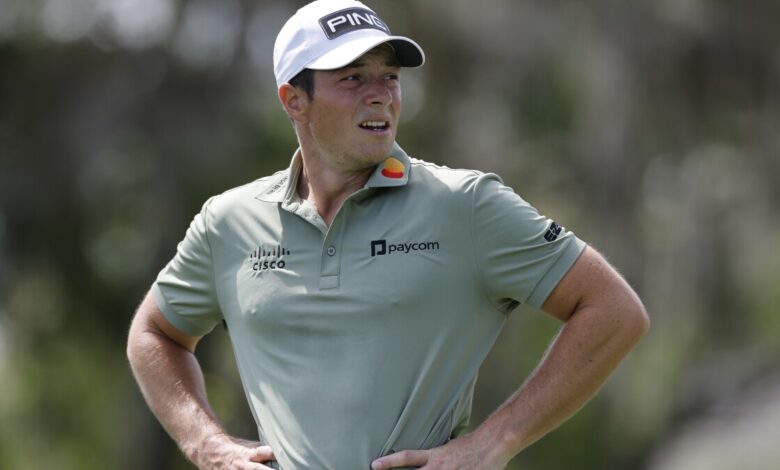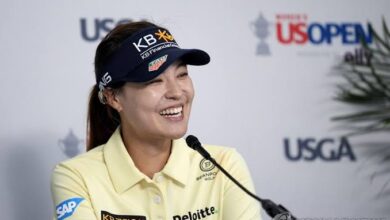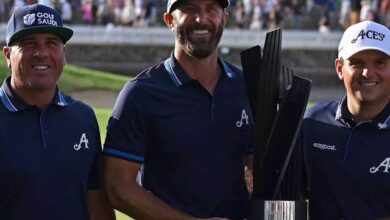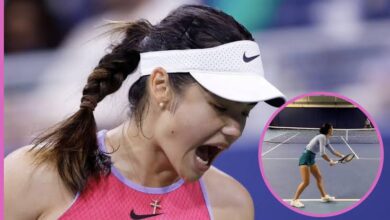Why would Viktor Hovland change his swing? It’s who he’s always been

It may be jarring to see Viktor Hovland on the range standing beside a new coach, tinkering with new gadgets, training new swing patterns.This was no time to blow it all up. He’s coming off the best year of his career, after all: FedExCup champion. Ryder Cup hero. More money than the modest man could ever spend in two lifetimes.
Ask anyone last fall who was playing the best golf on the planet, and the answer wouldn’t have been Scottie Scheffler or Jon Rahm or Rory McIlroy. It would have been Hovland, hands down, after he authored a searing run through the postseason.
So why is he here now, months later, searching for answers?
Sublime form is fleeting, even for the stars, but it isn’t that straightforward. Hovland willingly embarked on this journey. To access an even higher level, and to be more consistent, he decided to change coaches – again – and explore a different path.
“It’s going to sound a little dumb,” he said recently, “but I actually prefer my golf swing better in 2021. I feel like my ball-striking was the best.”
The stats suggest otherwise – last year was slightly better with his driver and approach play – but to Hovland, that’s not really the point. He enjoys, above all, the feeling of a flushed shot. The feeling of planning it and then executing it to perfection. That’s what he’s chasing. He’s done it before; he reached that higher plane in 2021. But last year, while fighting a draw when he prefers to see a fade, he wasn’t able to do that – even as he won big titles, even as he contended in majors, even as he blazed through the playoffs and Rome.
“He’s always deep in thought,” said Luke Donald, a former world No. 1 who served as Hovland’s European Ryder Cup captain in 2023. “He’s very passionate about being as good as he can be. He loves to learn everything about the game, deep-diving into techniques. Maybe too much sometimes, I would say. He just loves understanding stuff.”
The 26-year-old Hovland’s latest project is still under construction. Zero top-10s. A slipping world ranking. Shaky confidence. Critics have called what he has undertaken reckless, that there’s a difference between being curious and engaging in self-sabotage.
But that overlooks one inconvenient truth.
This is what Hovland has always done – and who he has always been.
TINKERING, EXPLORATION, EXPERIMENTATION – that desire has been ingrained in Hovland since an early age.
Maybe it’s in his nature; he’s the son of an engineer, and he remembers having lively discussions in the family’s living room in Oslo, Norway.
“It’s not bad to say, Hey, I don’t know, but let’s find out,” Hovland said. “That’s fun, instead of pretending that you know everything. That doesn’t seem to be very helpful in anything you’re doing. I guess the culture in Norway is like that, too. It’s fun to ask questions.”
The unique climate also helped foster that curiosity. Though juniors competed during the endless summer days, they often hunkered down during the winter months, or “indoor season,” when there were 19 hours of darkness to fill.
Why would Viktor Hovland change his swing? It’s who he’s always been
It may be jarring to see Viktor Hovland on the range standing beside a new coach, tinkering with new gadgets, training new swing patterns.
This was no time to blow it all up.
He’s coming off the best year of his career, after all: FedExCup champion. Ryder Cup hero. More money than the modest man could ever spend in two lifetimes.
Ask anyone last fall who was playing the best golf on the planet, and the answer wouldn’t have been Scottie Scheffler or Jon Rahm or Rory McIlroy. It would have been Hovland, hands down, after he authored a searing run through the postseason.
So why is he here now, months later, searching for answers?
Sublime form is fleeting, even for the stars, but it isn’t that straightforward. Hovland willingly embarked on this journey. To access an even higher level, and to be more consistent, he decided to change coaches – again – and explore a different path.
“It’s going to sound a little dumb,” he said recently, “but I actually prefer my golf swing better in 2021. I feel like my ball-striking was the best.”
The stats suggest otherwise – last year was slightly better with his driver and approach play – but to Hovland, that’s not really the point. He enjoys, above all, the feeling of a flushed shot. The feeling of planning it and then executing it to perfection. That’s what he’s chasing. He’s done it before; he reached that higher plane in 2021. But last year, while fighting a draw when he prefers to see a fade, he wasn’t able to do that – even as he won big titles, even as he contended in majors, even as he blazed through the playoffs and Rome.
So onto the next coach he went, in search of that feeling.
“He’s always deep in thought,” said Luke Donald, a former world No. 1 who served as Hovland’s European Ryder Cup captain in 2023. “He’s very passionate about being as good as he can be. He loves to learn everything about the game, deep-diving into techniques. Maybe too much sometimes, I would say. He just loves understanding stuff.”
The 26-year-old Hovland’s latest project is still under construction. Zero top-10s. A slipping world ranking. Shaky confidence. Critics have called what he has undertaken reckless, that there’s a difference between being curious and engaging in self-sabotage.
But that overlooks one inconvenient truth.
This is what Hovland has always done – and who he has always been.
TINKERING, EXPLORATION, EXPERIMENTATION – that desire has been ingrained in Hovland since an early age.
Maybe it’s in his nature; he’s the son of an engineer, and he remembers having lively discussions in the family’s living room in Oslo, Norway.
“It’s not bad to say, Hey, I don’t know, but let’s find out,” Hovland said. “That’s fun, instead of pretending that you know everything. That doesn’t seem to be very helpful in anything you’re doing. I guess the culture in Norway is like that, too. It’s fun to ask questions.”
The unique climate also helped foster that curiosity. Though juniors competed during the endless summer days, they often hunkered down during the winter months, or “indoor season,” when there were 19 hours of darkness to fill.
“His determination, his focus, better training in small parts – he was always very into finding the right things to do,” said Jens Giboe, the general manager of Hovland’s home club, Drøbak.
Growing up, Hovland scoured the internet for the latest methods and worked to implement them at an old airport hangar that had been transformed into an indoor driving range. Aiming at a target in the roof, he smacked balls and observed the flight for about 75 yards before its path was redirected.
“But that gets boring pretty quick,” he said. “So every day you’re doing a lot of swing work, a lot of technical stuff, trying to somehow get better.”
By his own admission, Hovland was not a standout junior. Harvard Johansen, the director of sport at Wang Academy, Hovland’s high school, said that Hovland wasn’t even one of the best players on the team. Fredrik Due, the sport manager at Wang, described him as “nothing special.” A former teammate at Wang, Sandra Nordaas, who played at Arizona, expressed surprise when Hovland first top-fived in a junior event. Those descriptions match up with the oft-cited recruiting story about Hovland, how Oklahoma State coach Alan Bratton ventured to the 2013 European Boys Championship to scout another Norwegian player, Kris Ventura, before becoming smitten with the youngest, newest and rawest member of the country’s national team. Bratton eventually extended Hovland a college scholarship, even though he had never won an event outside of Norway.
“I promise you I know what good is when I see it,” Bratton said, “and Viktor was good.”
Hovland had other appealing attributes, too. He was clever. He was determined. And, as a golf nerd, he was intensely curious.
“I want to get better. I want to improve. I like asking questions and turning over every single stone there is,” he said. “I’m very proud of the fact that I always just got better, a little bit better every single year.
“It doesn’t matter how far or how high you start, but if you keep improving all the time, you’re eventually going to climb the ladder pretty high. I saw a lot of guys who were super talented and they were by far the best at 13 or 15, but they didn’t really pan out.”
Hovland used the same swing instructor throughout his formative years but has always prided himself on his independence. He’d quiz his high school coaches about swing trends on Tour or his newest YouTube discovery or how best to optimize his Trackman numbers.
“He challenged us and asked us questions,” Due said. “And then he has this ability to filter out what he thought was sensible, what he thought was crap, and then he threw that away and went on doing the work that he believed in. He was quite independent at an early age.”
And it’s not just swing theory that piqued Hovland’s interest; he’s just as eager to dive into politics or astrology or aliens, or devour profound podcasts like “Theories of Everything,” or visit places like the Stonehenge or L.A.’s roughest neighborhoods. During his 2018 U.S. Amateur victory, he spent the lunch break of the 36-hole championship match reading a philosophical debate about affirmative action.
“It almost seems like society, in general, is trying to portray things in a very mundane and boring way. But the world is a lot more exciting than we think,” Hovland said. “The more questions you ask, the more rabbit holes you go down – it gives you more excitement and curiosity about where we are.”
That Hovland is such an enthusiastic learner, willing listener and independent thinker has only benefited his career and enriched his life. On a largely homogenous tour, he’s uniquely his own person.
“You’ve got to think for yourself,” he said. “There’s a lot of people out there that want to tell you how things work, and that doesn’t mean they’re necessarily wrong or right, but I think it’s definitely important to be open-minded and listen to other people while at the same time, looking at that information and then seeing, OK, does that fit with my opinions or my narrative? It’s just made me more comfortable in myself. It makes you a little bit more confident in yourself.”
View this post on Instagram
THAT HASN’T CHANGED NOW that he’s reached the elite levels of the sport, now that he has unfettered access to the top-ranked teachers, now that he has become a vast encyclopedia of technical swing instruction.
But there’s a difference, after all, between being analytical and asinine.
“You want to be open-minded,” Hovland said, “but you don’t want to be so open-minded that your brain falls out. So there’s a balance there.”
One of Hovland’s gifts is his ability to unemotionally judge the strengths and weaknesses of his game. Looking to weaponize his body, he shed some of his softness as a teenager to become a chiseled specimen in his mid-20s. Frustrated in college with his inability to get the ball airborne, he turned to a swing coach he’d discovered on social media to get more into his left side and compress the ball. During the COVID shutdown in 2020, he used the downtime to learn the AimPoint putting method that has significantly improved his make percentage inside 20 feet. A few years ago, he hired European tour player and noted stats guru Edoardo Molinari to better understand strategy and course management.
“I think that’s one of the reasons why he’s so good,” said Ryder Cup teammate Nicolai Hojgaard. “He always wants to improve. He always wants to find the small percentages. He’s probably more process-driven than he is results-driven. We all like results; we all like good finishes and wins and all that. But it’s so important to focus on the process of things and how to get better than the black-and-white results. If you focus on the small things, that’s where you get the big gains – and I think he’s really, really good at that.”
What began as one of those small things – his skittish short game – ballooned into a full-blown crisis. Having grown dissatisfied with countless coaches who told him the root of his problem was a bowed left wrist, Hovland last year underwent 3D imaging testing to diagnose the issue. Under the guidance of yet another instructor, Joe Mayo, Hovland altered his address position and, for a six-month stretch in 2023, became a top-25 player around the greens – a monumental improvement from a few years ago, when his stubbed pitches and bladed chips prompted him to declare on TV, “I suck at chipping.”
“People improve areas of the game all the time,” said world No. 12 Tommy Fleetwood, “but from his short-game standpoint, something that was made a big deal out of, it’s very rare to see somebody in a short space of time – and a year is a very short space of time – make something even close to a strength in a way. That has been really impressive.”
Watching Hovland’s transformation from back home in Norway, Due marveled at the same sort of dedication and insatiable thirst for knowledge he’d seen a decade earlier – how Hovland prioritized what was important to him and became his own coach.
“The incredible thing is that he says he wants to become a better putter, and then he just goes and does it. And then he says he needs to take care of his short game, and then he just becomes better,” Due said. “If you’ve ever tried to become a better golfer at almost any level, it’s not that easy. And he makes it look that easy.”
That’s why, last fall, Hovland appeared, for the moment, to be satisfied with his body of work.
He’d increased his speed off the tee and ranked fifth on Tour in total driving. He was inside the top 10 in proximity to the hole with his irons. He had developed not just an average short game and putter – but an above-average one. It’s hard to imagine a Tour player with a better understanding of the golf swing, and of techniques and concepts, allowing him, in his mind, to diagnose and fix on the fly.
“In my opinion, he’s complete,” Mayo declared last fall.
Ah, but that isn’t how Hovland’s mind works.
Even at tournaments he won, such as the Memorial, Hovland believed that it was his previously maligned short game that bailed him out. That his inconsistency with his longer clubs wasn’t sustainable – especially when tasked with going up against a generational ball-striker like Scheffler. He needed to plan a shot and then execute, just as he’d drawn it up.
“I think it’s a better indicator of how you’re going to play in the future,” he said.
Hovland hasn’t explained much about his latest changes in direction, including why he’s no longer working with Mayo, and why he was consulting with Dana Dahlquist, not Grant Waite, on the tournament practice area on Monday at the Masters: “I’m a very curious guy. I like to ask questions. Sometimes when you ask a question, and you get some answer, that leads you down a different path and opens up some new questions and you pursue a different path.”
Hovland, who is believed to have gone through more than a half-dozen coaches since turning pro, has been coy about what he’s working on, offering only that he’s pressuring the ground differently.
“It’s just a matter of trying to get the swing started the right way,” he said, “and I should be able to find my groove from there.”
That search is still ongoing.
Entering the Masters, Hovland has played just five times (two fewer than last year) as he toils away from the spotlight. Statistically, he has suffered, ranking a stunning 133rd on Tour from tee to green, actually losing strokes to the field with his ball-striking – what has historically been his greatest asset. Worse, his short game has regressed to its pre-2023 levels, owing, perhaps, to a change in technique or possibly less dedicated attention while the full swing gets sorted.
Whatever the case, it’s been a slower process than he anticipated – the hidden downside to his quest for hard-earned knowledge.
“I wish it was as simple as overnight, one feel, and then we’re back on it,” he said. “This is kind of a project, but it gives me something to work on, and I believe that when this starts to get easier and easier to do, it’s going to be right back to where we were.”
Or better.
That’s what underpins every decision.
“I know I can fix these things,” he said, “because I have shown it.”



